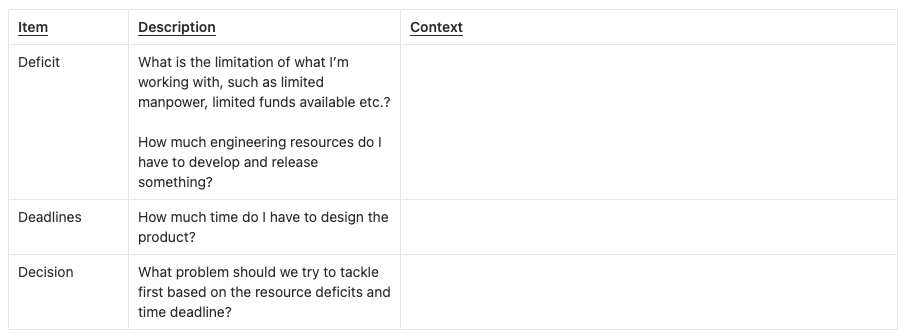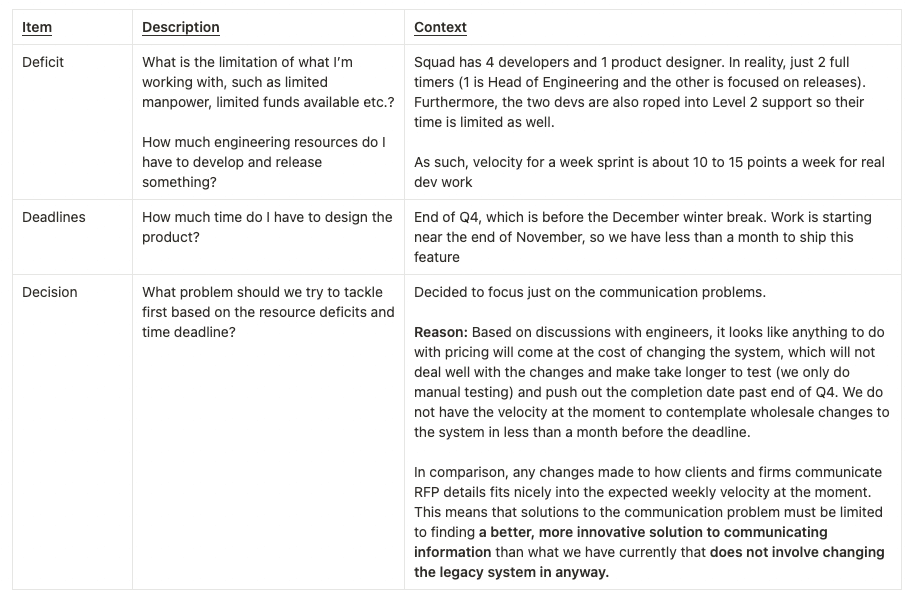The Deficit, Deadline & Decision matrix helps product managers prioritize what problem or feature to tackle first.
One of the key decisions that a PM will have to make throughout their career is what will you prioritize to get built next. Whether it’s a new feature for an existing product, a problem that’s cropped up based on quantitative or qualitative data, or building a new product line entirely, it's up to the PM to decide what gets built first, what needs to be considered straight after and what ideas, features and problems go straight into the bin.
The way that you can do this is by using a Deficit, Deadline & Decision matrix. This is a matrix I’ve developed based loosely around the ‘C’ in the CIRCLES method (more on this method to come). The goal is to help you decide, based on your resource deficits and looming deadlines, which idea, feature or problem you and your squad should prioritize first.
What is the CIRCLES method?

Created by Lewis C. Lin, the CIRCLES method is a comprehensive problem-solving framework that helps product managers make a decision to prioritize which ideas, features or problems to tackle first. CIRCLES stands for the following:
Comprehend the situation (What? Why? Who? How?)
Identify the customer
Report customer’s needs
Cut, through prioritization
List solutions
Evaluate tradeoffs
Summarize your recommendation
You can read more about the CIRCLES method here. As mentioned previously, the Deficit, Deadline, and Decision matrix are based loosely around ‘Comprehend the situation’ — the first C of the CIRCLES method.
What does ‘Comprehend the situation’ mean?
To summarise, there are three steps to take in order to have a total comprehension of the situation:
1. Clarify the goal
The company or business must establish what they are trying to accomplish by launching and designing a specific product or service e.g. market share or revenue maximization.
2. Understand the constraints
As the PM, you must understand the limitations of what you are working with, such as limited manpower, limited funds available, time constraints or infrastructural inadequacies.
3. Understanding context
Finally, you need to understand the context in which the product is being designed and the answers to the question of why, for whom, and how the product is being designed. This must be solid and founded on research and not mere guesswork or assumptions.
What is the Deficit, Deadlines & Decision framework?

Moving on to the actual framework itself, the Deficit, Deadlines & Decision framework is meant to help you both understand the constraints and the context that you’re working under in order to make a decision about the idea, feature or problem you’d like to work on first to achieve the overarching goal.
The above screenshot is a template of the Deficit, Deadlines & Decision framework. The following is a step by step guide on how to use the above template:
1. The first step is to think about the goal you’re trying to achieve
The goal can be based on anything. It could be a new feature the executives or the squad is thinking of releasing and wants your opinion about it, a problem that you’ve discovered based on verbal/written feedback or a glance at your data dashboard that’s telling you something is wrong.
2. Then, think about your resource and time constraints (Deficit & Deadlines)
Whatever it may be, it’s your job as a PM to decide what needs to be prioritized first. Resource and time constraints are important factors in determining what and how long your squad will work on something, simply because nobody has the capacity to work on everything people want built at the same time.
At a basic level, you can’t build all of the above at the same time simply due to two of the following factors:
- You don’t have enough people in the squad to build multiple features or to tackle different problems at the same time (resource constraints)
- There are tight deadlines you need to hit in order to deliver certain features or benefits promised in a roadmap, usually within a certain quarter (time constraints)
Hence, the Deficit, Deadlines & Decision framework is there to help you:
- Focus on the resource and time constraints that you and your squad are experiencing; and
- By weighing up these constraints, figure out what problem or feature should be prioritized first.
3. After focusing on your Deficit & Deadlines, it’s time to come to a Decision
By weighing up the facts on the ground with respect to your resource and time constraints, you’re armed with enough information to make a preliminary decision around what feature, problem or idea you would like to work on first.
An example of how I used the Deficit, Deadlines & Decision framework recently was with my previous company, where I had to weigh up between working on either implementing a unique identification system for all the documents that get sent through the platform, or fixing up an interactive module in our product that helped users determine the price for services.
The following table details the way that I thought through which problem to solve first, using the Deficit, Deadlines & Decision framework:

Conclusion
I hope the above helps both aspiring and practicing PMs to hone their decision-making skills, and to make the first pass at prioritizing what needs to be built by focusing on your resource and time constraints. Until the next time!



 Follow us on LinkedIn
Follow us on LinkedIn



